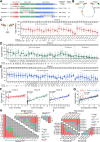The modern expansion of Dscam1 isoform diversity in Drosophila is linked to fitness and immunity
- PMID: 40938900
- PMCID: PMC12431208
- DOI: 10.1371/journal.pbio.3003383
The modern expansion of Dscam1 isoform diversity in Drosophila is linked to fitness and immunity
Abstract
Drosophila melanogaster Down Syndrome cell adhesion molecule 1 (Dscam1) gene encodes 38,016 diverse cell surface receptor proteins via alternative splicing, which have both nervous and immune functions. However, it remains elusive why organisms have evolved such an astonishing diversity of isoforms. Here, we show that fitness and immunity properties have driven the modern evolution of Dscam1 isoform diversity. We assess multiple aspects of fly fitness in deletion mutants harboring exon 4, 6, or 9 clusters, respectively, reducing ectodomain isoform diversity stepwise from 18,612 to 396. All fitness-related traits generally improved as the potential number of isoforms increased; however, the magnitude of the changes varied remarkably in a variable cluster-specific manner. Correlation analysis revealed that fitness-related traits were much more sensitive to reductions in Dscam1 diversity compared to canonical neuronal self/non-self discrimination. We conclude that the role of Dscam1 isoforms in canonical neuronal self-avoidance and self/non-self discrimination is mediated by a small fraction of all isoforms (<1/10), whereas a separate role essential for other developmental contexts and resistances, likely in fitness and immunity, requires almost full isoform diversity. Thus, fitness and immunity properties, rather than canonical neuronal functions, are the dominant drivers during the modern diversification of the Dscam1 isoform. Our findings suggest that Dscam1 diversity is closely linked to adaptation and species diversification in arthropods.
Copyright: © 2025 Dong et al. This is an open access article distributed under the terms of the Creative Commons Attribution License, which permits unrestricted use, distribution, and reproduction in any medium, provided the original author and source are credited.
Conflict of interest statement
The authors have declared that no competing interests exist.
Figures








Update of
-
A systematic CRISPR screen reveals redundant and specific roles for Dscam1 isoform diversity in neuronal wiring.PLoS Biol. 2023 Jul 6;21(7):e3002197. doi: 10.1371/journal.pbio.3002197. eCollection 2023 Jul. PLoS Biol. 2023. Update in: PLoS Biol. 2025 Sep 12;23(9):e3003383. doi: 10.1371/journal.pbio.3003383. PMID: 37410725 Free PMC article. Updated.
References
MeSH terms
Substances
LinkOut - more resources
Full Text Sources

